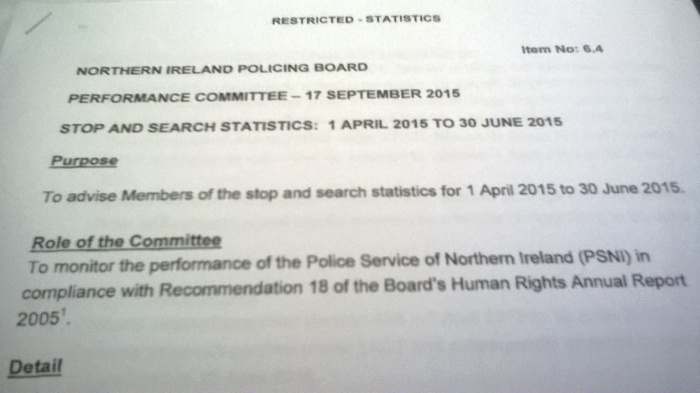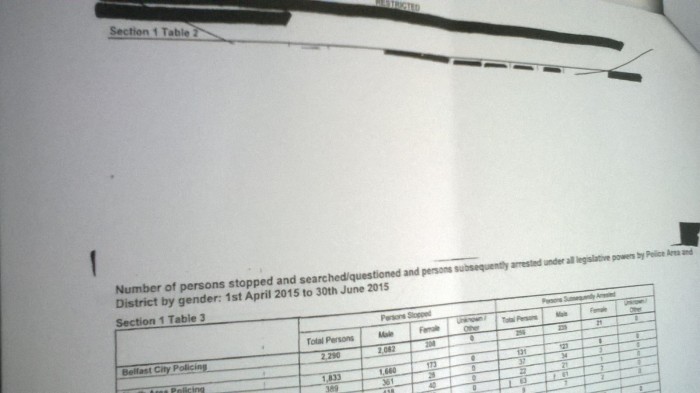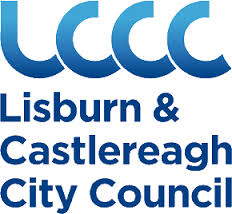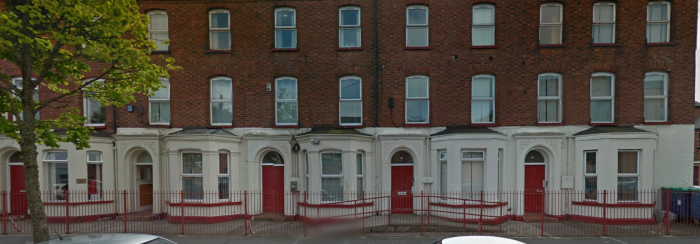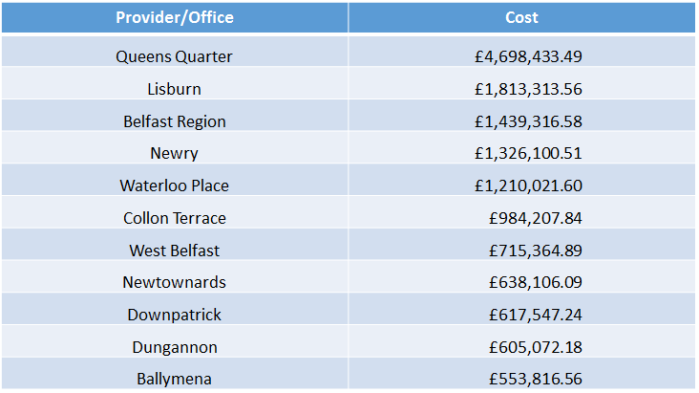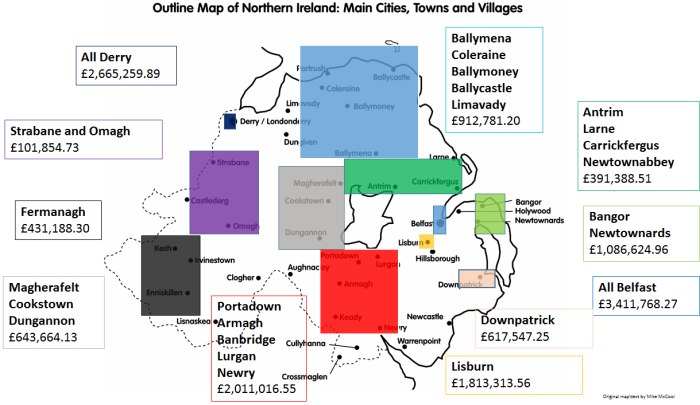Private finance initiatives are used by governments to build public projects such as schools or hospitals using private finance, which is then paid back each year via a ‘unitary charge’ which includes part of the cost of the building – just like a bank loan.
Until the full amount is paid back to investors, the private funders manage and own the asset, which is not passed into public ownership until all unitary charges have been paid.
Northern Ireland has 39 PFI projects in total, with six of these having been completed and paid for.
The cost of building all of these assets came to a whopping £1.987 BILLION which is eclipsed when we reveal that the amount of money you the public will pay back in total when all the contracts are completed is an eye-watering £7 BILLION (£7,085,000,000). Let’s put that in context.

The entire budget for the Department of Education agreed by the Executive for 2016-2017 is £1.947bn. The budget of the Department of Health in the same period is £4.88bn. Our PFI debt is more than these two budgets added together. Indeed, the original cost of just building all of these projects is largely equal to the Department of Education’s budget – £1.987bn.
Let’s look at these projects, what they originally cost, what they will cost us when the PFI ends, and who oversaw the deal.
The six deals that are complete range from projects started in 1996 (New Renal Dialysis facilities) to a huge upgrade of schools IT infrastructure, the last project of which started in December 2004 by the Dept of Education. To give an idea of the terms of some of these deals, a project entitled ‘Electronic Libraries for Northern Ireland’ cost £10.2 million to complete, but the public paid £38.37 million in total after the ten year lease. The renal dialysis project referred to above cost £2.85 million but at the end of the 15 year lease, the public had paid ten times that – £24.97 million.
The largest PFI project in Northern Ireland is referred to as ‘Roads Service DBFO Package 2’ DBFO refers to ‘Design, Build, Finance and Operate’. The contract was awarded to Amey in 2007 and completed two years later – it cost £250 million to build. The details can be found here. When the 30 years contract is completed, it will cost £1.076 billion – four times the original cost to build.
The Department of Education currently has 11 projects under PFI contracts, the largest of any public body. The total cost to originally build the 11 projects was £245 million – but when the contracts are completed, some with still 20 years to go, the total cost to the public purse is £733 million.
The Department of Employment and Learning come second, with major projects such as the new buildings for Belfast Met, North West Regional College, South East Regional College and South West College. All of the DEL projects cost £150 million in total, but when the contracts are completed, again some with 20 years still left to run, it will have cost £865 million.

A number of Health Trusts have undertaken PFI projects, 6 in total. They cost £335.44 million – but when the contracts are paid off, some decades in the future, the public will have paid £1.015 billion.
Northern Ireland Water is next with three PFI projects to upgrade water treatment works. These were build at a cost of £144 million, but when the contract ends, we will have paid £1.191 billion. (Details here)
The Department of Regional Development has two massive PFI contracts to upgrade infrastructure, one we have already referred to. The contracts cost £367 million to build, but when the contract is complete on both, we will have paid £1.638 billion.

The Department of Culture, Arts and Leisure has one project, the building of Lisburn City Library at a cost of £3.7 million. It will cost the taxpayer £11.6 million when the contract is complete in 2030.
In a particularly hard pill to swallow for many, the sole Department of Enterprise, Trade and Investment PFI project was the building of the InvestNI HQ in Belfast at a cost of £25 million. When the contract on it completes in around 2037, the taxpayer will have paid £129.15 million.
Another very strange project indeed is referred to as ‘LandWeb’ managed by the Department of Finance – this cost nothing to build, the information we have tells us, yet when the PFI contract is completed in the summer of 2019 – it will have cost the taxpayer £91 million. (We have contacted the Department to clarify)
Last but not least is the building of the Laganside Courthouse by the Department of Justice. It cost £24.48 million to complete, but by the time we are finished paying, it will have cost us £110.47 million. We do not even own the building at the present time – the contract does not conclude until 2024.

Large sections of our critical infrastructure – roads, schools, courts – are not in public hands and we are paying private interests because of these deals undertaken by the Executive.
So, who authorised these deals?
Of the 11 Department of Education projects, three were authorised by direct rule ministers in 1997. However, all of the rest were authorised when Sinn Fein headed the Department.
(SF Education Ministers; Martin McGuinness, Catriona Ruane, incumbent John O’Dowd)
Of the Department of Employment and Learning projects, two were initiated pre-devolution, 2 others were initiated when SDLP Minister Sean Farren was at the helm and the remaining during the period the Assembly was suspended, under Direct Rule ministers.

(Former SDLP Employment and Learning Minister Sean Farren)
The Northern Ireland Water projects were all started under Direct Rule ministers – in 1995 pre-devolution, and during the suspension in 2004 and 2005 as was the controversial ‘landweb’ project under DFP.
Of the Health Trust projects, all started under pre-devolution Direct Rule ministers, either pre-devolution or during a period of suspension, the same with all three of the NI Water projects and the two Road Service projects.
The UUP’s Michael McGimpsey was the Minister in DCAL when their sole project was initiated.

(Former DCAL Minister, UUP MLA Michael McGimpsey)
A Direct Rule minister initiated the building of the InvestNI HQ project, much to the relief of our politicians, and the new Laganside Courthouse was initiated long before policing and justice were devolved to the Assembly.
Where are these projects?
Two of the projects are situated in East Belfast, four in West Belfast, 3 in South Belfast.
Two are situated in Foyle, 1 in South Down and 2 in Lagan Valley.
Three in Fermanagh and South Tyrone, one in Mid Ulster and one each in West Tyrone, South Antrim, North Down and East Londonderry. The remaining eleven cross constituency boundaries and as such are listed as being in ‘more than one’ constituency.
Who owns the assets now?
Seventeen of the projects are currently owned by one shareholder. For example, the Royal Victoria Hospital Carpark is owned by a company called Car Parking Services Ltd. They run a number of car parks throughout NI.
The Lisburn City Library is owned by Turkington Holdings, who were at the centre of a controversial debate in the Assembly about Housing Executive contracts.
One of the schools IT projects is wholly owned by the IT giant Hewlett Packard and the strange asset known as ‘landweb’ which seemingly cost nothing to build but will cost taxpayers £91 million is owned by BT.
Laganside Courts is owned by Consul Services Holdings Ltd – and two of the directors of Turkington Holdings Ltd are also directors alongside the owner of the Obel Tower.
In another strange twist, part-nationalised bank Allied Irish actually own 24.5% of Enniskillen Hospital (South West Acute Hospital). Some Unionists in the county might not be very happy to know the Irish Government owns a quarter of a local hospital.

The bank HSBC also owns 45% of the equity in Grosvenor Grammar, Belfast Boys Model School, Belfast Model Schools for Girls and Ashfield Girls School, one primary school (Orangefield Primary School), and two nursery schools (Ravenscroft and Glendhu).
PFI costs are a staple of our financial outgoings in the next number of years, even decades, despite the questionable return to the public.
